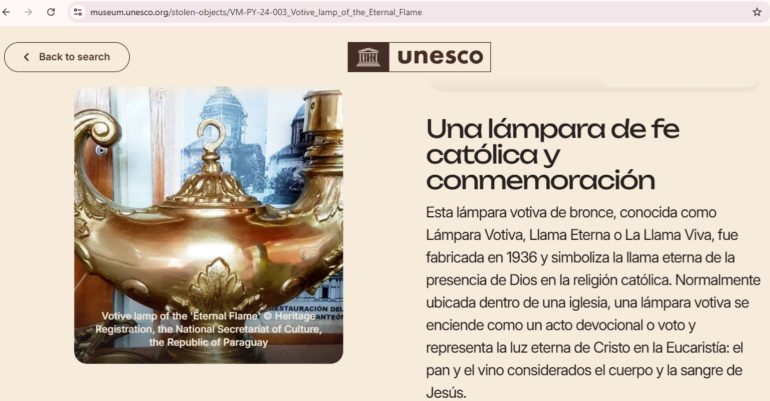The United Nations Educational, Scientific and Cultural Organization (UNESCO) presented a project of virtual museum at the 2025 Mondiacult, the world’s largest conference on cultural policy. Paraguay collaborates with UNESCO to feature two national artefacts: an incense burner from the Independence House Museum, and a hanging lamp from the National Pantheon of Heroes.
The virtual museum isdeveloped to raise awareness about the illegal trafficking of cultural artefacts. This is one of the biggest challenges for preservation and maintenance of heritage objects. Using 3D technology and virtual reality, the virtual museum presents artefacts from across the globe. Each item includes descriptions, educational guides, and testimonies from communities affected by theft or disappearance.
Paraguay’s contribution to cultural memory
The incense burner was stolen in 2010 from the Independence House Museum. Made of carved and embossed silver, it dates from the late 18th century, at the end of Paraguay’s colonial period. Although of European origin, it has strong ties to the country’s religious traditions.
Donated in 1965 by priest Enrique D’Agostini, it was used during Catholic masses. The act of censing is believed to cleanse both physically and spiritually, preparing the space for worship. Estela Riquelme, a guide at the museum, recalled that the theft represented a “painful moment for the country and its cultural heritage.”
Lámpara Votiva
The bronze votive lamp, known as Lámpara Votiva or La Llama Viva, was created in 1936. The item symbolises the eternal presence of God in Catholic faith. Typically housed in churches, votive lamps are lit as devotional acts, representing the everlasting light of Christ in the Eucharist.
This lamp features embossed leaf motifs and measures 20 centimetres high, 30 centimetres wide, weighing 10 kilograms. Electrically lit, it was displayed outside the National Pantheon of Heroes in Asunción. The lamp is marking the site as sacred and commemorating important national figures.
“It was a great loss when that beautiful lamp, which was dedicated to the Virgin and our heroes, was stolen,”Ana María Rodríguez, steward of the altar of the Virgin. “Its absence was deeply felt by all.”
National commitment to preserving cultural artefacts
Featuring these objects in the virtual museum highlights Paraguay’s dedication to protecting its heritage. Both items hold strong historical and emotional value, linked to the nation’s independence and prominent figures.
Natalia Antola, director of Cultural Heritage at the National Secretary of Culture: “Together with the National Commission to Combat Illicit Trafficking, we work to preserve memory, history, and cultural assets. Identifying and registering these items is essential for filing claims and preventing future thefts.”
A shared responsibility
Illegal trafficking of cultural property remains one of the world’s most complex cultural crimes, involving collectors, smugglers, and auction houses across continents. Through the virtual museum, UNESCO emphasises that heritage protection is a shared responsibility.
By showcasing stolen or displaced artefacts, the project encourages stronger laws, greater public awareness, and international cooperation. Paraguay’s participation underscores its commitment to these goals, ensuring that memory, art, and identity remain safeguarded for future generations. Paraguay recently launched its candidacy to join the UNESCO Heritage World Committee.


